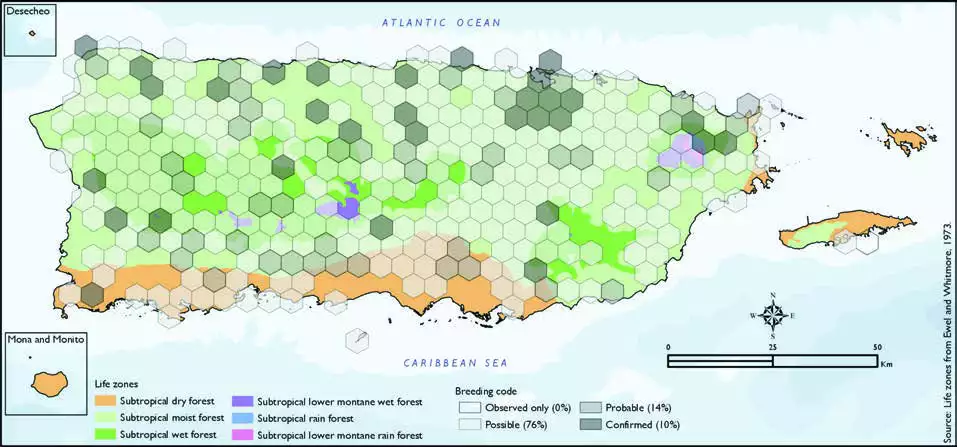Red-legged Thrush
Description
The red-legged thrush (Turdus plumbeus) is a species of bird in the family Turdidae. Native to the Caribbean, it is found in the Bahamas, Cayman Islands, Cuba, Dominica, Hispaniola (the Dominican Republic and Haiti) and Puerto Rico. It formerly occurred on the Swan Islands, Honduras, but was extirpated there.
This large thrush measures 27 cm (11 in) and weighs approximately 75 g (2.6 oz), depending on subspecies. It is mainly bluish-grey above and lighter-grey below with a white and black throat with a striped appearance. The legs, bill and eye ring are bright orange-red. There is notable variation in plumage between the subspecies.
Distribution & Habitat
The Red-legged Thrush is a year-round resident throughout
the Greater Antilles (except
Jamaica), The Bahamas (Oberle
2018, Raffaele and others 1998),
the Cayman Islands (Raffaele
and others 1998), and Dominica
(Oberle 2018, Raffaele and
others 1998). In Puerto Rico,
it is common and widespread
on the main island (Oberle
2018, Raffaele 1989a) and a rare
visitor on the island of Vieques
(Gemmill 2015). This species
inhabits woodlands and forests
at all elevations (Raffaele and
others 1998), as well as coffee plantations (Oberle 2018,
Raffaele and others 1998) and
gardens (Oberle 2018, Raffaele
and others 1998). The atlas
fieldwork yielded a total of 520
records within 303 hexagons
or 63 percent of the 479 total
hexagons (see map). Of the 303
hexagons where this species
was found, breeding was
confirmed in 10 percent (31)
of the hexagons, probable in
14 percent (42), and possible
in 76 percent (229), while the
species was also observed in an
additional hexagon (<1 percent)
but without evidence of breeding
(see map). Red-legged Thrush distribution. The map shows the highest breeding code by hexagon and overlaying the ecological life zones in
Puerto Rico. Note: percentages may not total 100 due to rounding. 227Red-legged Thrush/Zorzal Patirrojo

Breeding Habits
The Red-legged Thrush builds a bulky nest made of leaves,
grass, and other material,
usually placed up in a tree,
but sometimes in a palm or on
a stump (Raffaele and others
1998). Previously published
reports indicate that it breeds
from January to September,
but breeding peaks from April
to July (Raffaele and others
1998). Atlas results show that
this species breeding season
extends throughout the year,
with the most breeding activity
from March to June (see chart).
Overall, the breeding activity
peaks in April, and it mostly takes place in the subtropical
moist forest life zone (see
chart). Results show that this
species breeds mostly within
the subtropical moist forest
life zone (63 percent of the
hexagons) (see table and map),
to a lesser extent in subtropical
wet forest life zones (23 percent
of the hexagons), and within
subtropical dry and subtropical
rain forest life zones as well (14
and <1 percent of the hexagons,
respectively) (see table
and map).
Conservation
The global population size of the Red-legged Thrush has not been quantified. However,
the population is suspected
to be stable due to the lack of
evidence for any declines and
threats (BirdLife International
2016). It is currently listed as a
species of least concern by the
IUCN (BirdLife International
2016). Locally, this species is not
listed in any of the threatened
categories of PRDNER and
USFWS. In Puerto Rico, the Red-
legged Thrush has a protected
habitat of 13 percent or 967 km2 of the total area covered by the
hexagons where this species is
known to breed (7222 km2).
Related Species
Family:
thrush